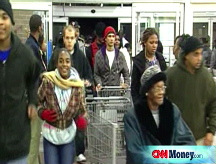Dow, S&P 500 in 5-day win streak
Major indexes advance at the end of a thinly traded, post-holiday session.
NEW YORK (CNNMoney.com) -- Stocks rallied in a shortened holiday session Friday, with the Dow and the S&P 500 ending higher for the fifth session in a row, capping one of Wall Street's best weeks in months.
The Dow Jones industrial average (INDU) rallied 1.2%, or 102 points, which brings the blue-chip average's gains for the week to 785 points. For the month, however, the Dow has lost 489 points.
Friday's advance marks the first time the Dow has held gains for 5 consecutive sessions since Nov. 17, 2007.
The Standard & Poor's 500 (SPX) index ended 1% higher and the Nasdaq composite (COMP) rose 0.2%.
The S&P 500 advanced 96 points in the week and is up about 30 points for the month. The tech-heavy Nasdaq tumbled 191 points this week but gained a total of 151 points in November.
U.S. markets were closed Thursday for Thanksgiving, and Friday's session ended at 1 p.m. ET. Trading was light with many market participants on vacation.
Friday's advance comes at the end one of the best weeks Wall Street has seen in months.
"The upward movement has to do with the latest installment of the government's bailout plan," said Abigail Doolittle, a portfolio manager at Johnson Illington Advisors, which has nearly $700 million in assets under management.
Doolittle also pointed to the "psychological benefit" of President-elect Barack Obama's nominations of key financial officials, which she said were "more conservative" than the market had anticipated.
The Dow surged nearly 400 points Monday, extending gains from the previous session, as investors cheered the government's rescue of banking giant Citigroup (C, Fortune 500) and Obama named New York Federal Reserve Bank President Timothy Geithner as his choice for Treasury secretary.
Tuesday's advance was less dramatic as dour economic reports vied with news that the government will provide roughly $800 billion to increase the availability of consumer and mortgage lending.
Stocks rallied across the board Wednesday after Obama said former Fed Chairman Paul Volcker will head his economic advisory board.
Looking ahead, weekly and monthly reports on the nation's beleaguered labor market could pressure the market. And an initial reading on what is expected to be a weak holiday sales period could also push stocks lower.
"The market seems to have a very short memory," Doolittle said. This week's gains could be forgotten if next week's economic news reflects "the dire fundamental picture," she said.
Black Friday: Investors are closely watching the retail sector as the nation goes into holiday-shopping mode. On "Black Friday," the day after Thanksgiving, retailers are offering deep discounts to kick off what is traditionally the sector's most profitable time of year.
However, consumers have drastically cut back on spending as unemployment continues rising, home values are plummeting and financial markets remain tumultuous. The trend is expected to continue through the holidays.
The National Retail Federation (NRF) forecast holiday sales to rise just 2.2% this year, which would make it the weakest sales gain in six years.
With consumer spending accounting for nearly two-thirds of the nation's total economic activity, a weak holiday sales period could further the market's perception that a prolonged recession is on the horizon.
Still, the market may find some support if Black Friday sales look like they could beat such low expectations, Doolittle said.
"Some people are feeling positive about the large flows of people into the malls, whether or not they're buying anything," she said.
Other markets: In global trade, Asian markets rose as the crisis arising from the terrorist attacks in India entered their third day. Major indexes in Europe were mixed.
Prices for U.S. Treasurys rose. The benchmark 10-year note advanced 1-20/32 to 107-4/32 and its yield fell to 2.92% from 2.99% on Wednesday. The yield fell below 3% for the first time in history during the previous session.
Treasury prices and yields move in opposite direction and lower yields suggest that investors are less concerned with profits and more focused on safety.
The dollar gained versus the euro and the yen.
U.S. light crude oil for January delivery fell 1 cent to $54.43 a barrel.
COMEX gold for February delivery rose $7.17 to $819 an ounce.
Gasoline prices continued the fall to nearly four-year lows, with gas down 1.1 cents to a national average of $1.835 a gallon, according to a survey of credit-card swipes released Wednesday by motorist group AAA. Prices have been sliding for more than two months, losing almost $2 a gallon or 51%. ![]()




